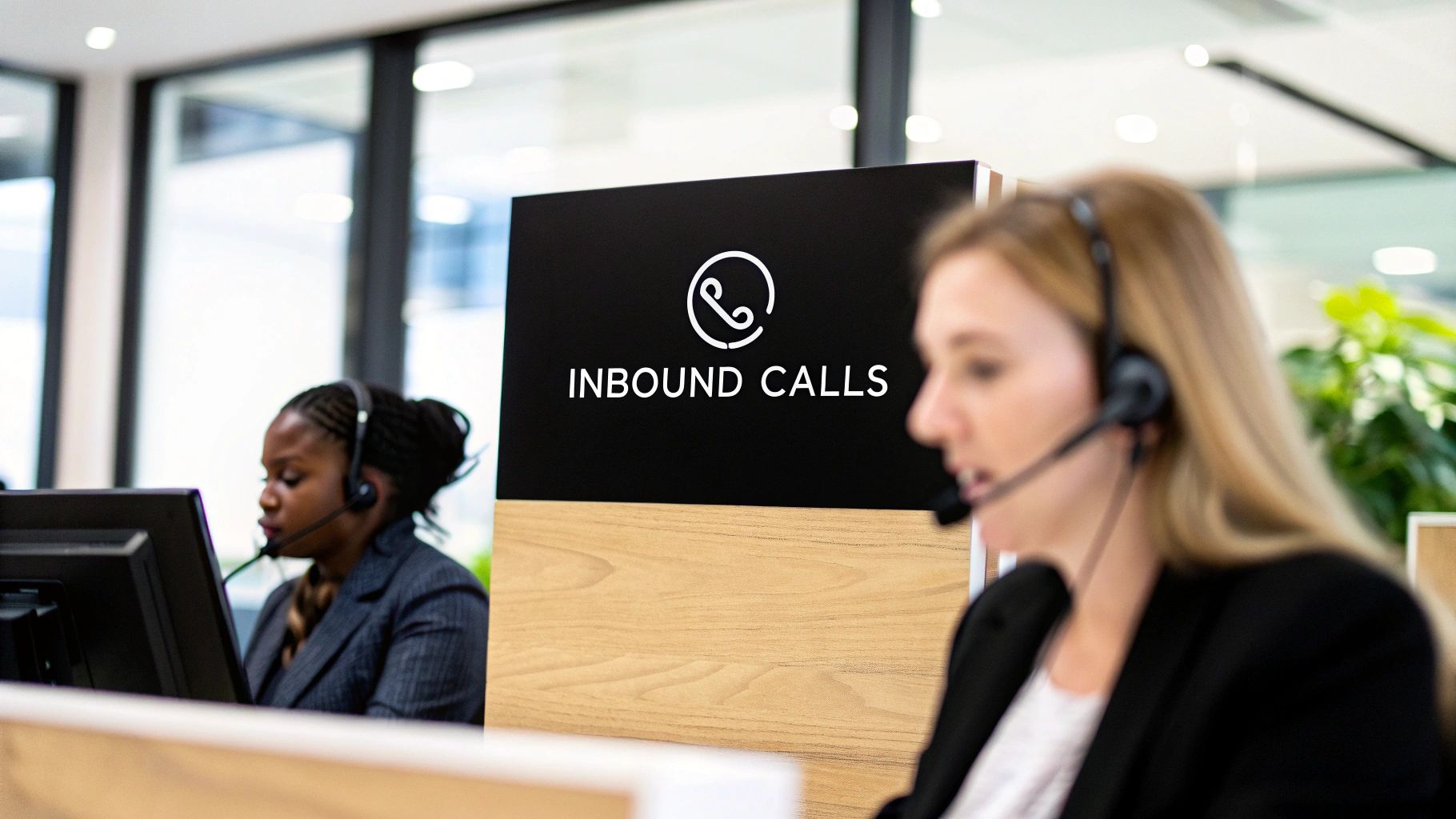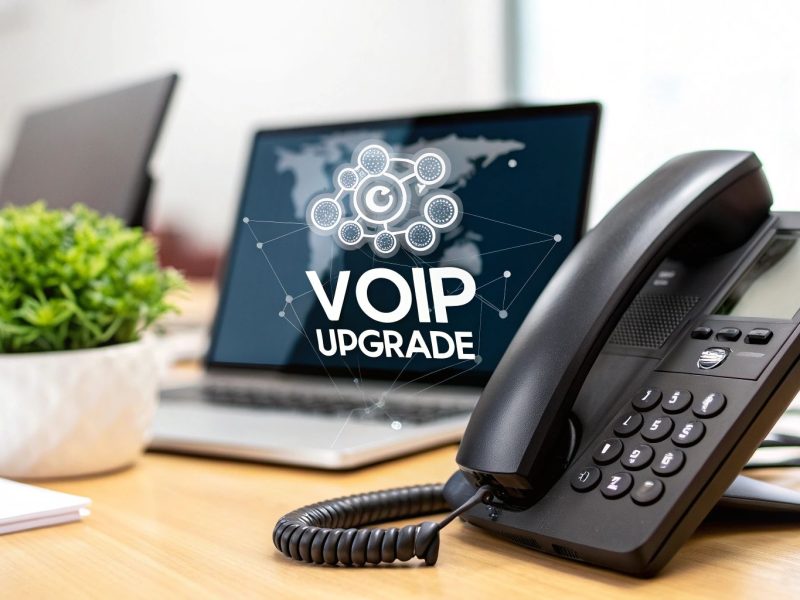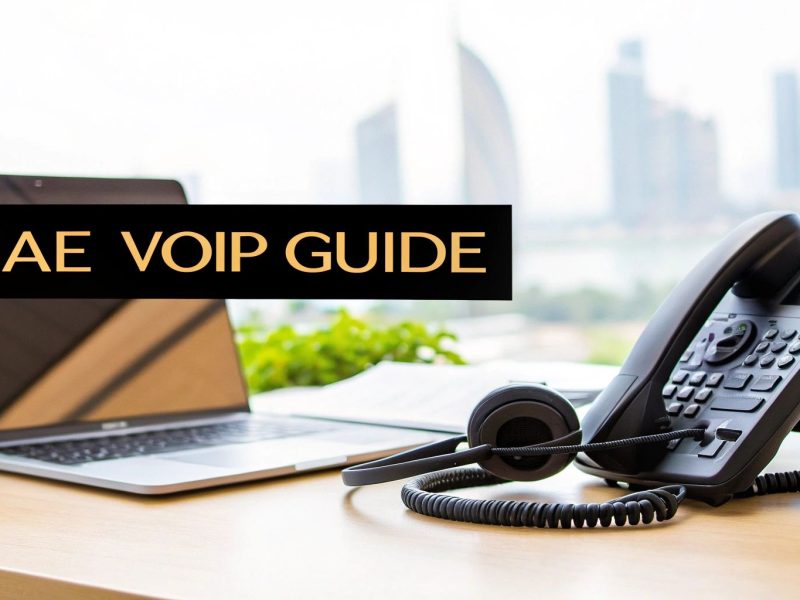At its heart, an inbound call is simply a conversation that a customer starts by contacting your business. They’re the ones picking up the phone to ask for help, get information, or buy something.
Think of it this way: a customer is actively walking through your company's front door. They've already decided they need you, which is what makes these interactions so valuable.
What Does Inbound Call Really Mean

The definition might seem straightforward, but the impact on your business is huge. Every single inbound call is what we call a "high-intent" interaction. The customer has already done the heavy lifting—they found your number and made the choice to connect. This isn't a cold call; it's a warm conversation waiting to happen.
This is the key difference from outbound calling, where your team is the one reaching out. An inbound call is reactive; your job is to respond to what the customer needs, right here and right now.
An inbound call is more than just a phone ringing; it's an opportunity served on a silver platter. It provides a direct line into your customer's immediate needs, challenges, and interests.
Inbound vs Outbound Calls A Clear Comparison
Putting the two call types side-by-side really helps clarify their distinct roles. Each one requires a different strategy, a unique agent skillset, and specific tools to get the job done right.
Here's a quick-glance table to break down the fundamental differences.
| Characteristic | Inbound Calls | Outbound Calls |
|---|---|---|
| Initiator | Customer-initiated | Business-initiated |
| Primary Goal | Customer support, issue resolution, order processing | Lead generation, sales, market research |
| Nature | Reactive (responding to a need) | Proactive (creating a need or opportunity) |
| Agent Skillset | Empathy, problem-solving, active listening | Persuasion, resilience, rapport-building |
Grasping this core difference is the first step toward building a team that excels at managing these valuable, customer-driven conversations.
When you see each inbound call as a chance to strengthen a relationship or solve a problem, you unlock its real power. It’s how you build real loyalty, one conversation at a time. This mindset shifts your contact center from being just a business expense into a genuine engine for customer happiness and retention.
The Strategic Value of Every Inbound Call

It’s easy to think of inbound calls as just another task to manage, but that’s a huge mistake. These aren't just service requests; they're your front line for building real customer relationships, solving problems on the spot, and even closing sales with motivated buyers. Think about it: when a customer picks up the phone to call you, they're already invested.
The connection between how you handle these calls and your bottom line is direct and powerful. Get it right, and you'll see customer satisfaction climb, brand loyalty solidify, and revenue grow. It’s time to stop seeing your phone lines as a cost center and start treating them like the growth engine they truly are.
This shift in perspective is happening across the United Arab Emirates (UAE) and the wider Middle East & Africa (MEA) region. As of 2025, the market for inbound call tracking software in the MEA region alone was valued at roughly USD 798 million. That number tells a story about how seriously businesses are taking customer service. You can read more about MEA's inbound call tracking market on globalgrowthinsights.com.
Unlocking Business Intelligence
Every single inbound call is a goldmine of data. These conversations are packed with raw, unfiltered insights into what your customers are thinking, what they need, and where your products might be falling short. By analyzing this call data, you can spot common pain points and get a much clearer picture of your customers' world.
This isn't just a job for the support team. The intelligence you gather can shape everything from your next marketing campaign to your product development roadmap. All you have to do is listen.
Each call is an opportunity to learn. It’s a real-time focus group that tells you exactly what your customers think, what they need, and how you can serve them better.
Measuring What Matters
You can't improve what you don't measure. To really grasp the impact of your inbound operations, you have to track the right performance indicators. Key metrics give you a clear, objective view of your team's efficiency and the quality of the customer experience you're delivering.
We have a guide that breaks down which contact centre KPIs are most important if you want to dive deeper. A focus on measurement is what elevates your support function from a simple necessity to a strategic asset that delivers real business results.
How Modern Contact Centers Manage Inbound Calls
When a customer calls your business, what happens next is a carefully orchestrated sequence, not just a game of chance. Modern contact centers have moved far beyond the simple switchboard, now using a sophisticated, automated system to manage the flow of inbound calls. Think of it as an intelligent traffic control system for your customer communications.
The first point of contact is almost always an Interactive Voice Response (IVR) system. This is the familiar automated menu that greets you with options like, "Press 1 for Sales, Press 2 for Support." It acts as a digital receptionist, performing an initial triage to understand why the customer is calling, all before a human agent even gets involved.
Once the IVR identifies the caller's intent, the baton is passed to the Automatic Call Distribution (ACD) system. The ACD is the real brains of the operation. Its job is to figure out which agent is the perfect match for that specific call.
The Smart Routing Process
The ACD doesn't just randomly pick the next available person. It uses a much smarter approach called skills-based routing. This method is all about matching the caller's need with an agent who has the right skillset to handle it effectively.
For instance:
- A call flagged as a billing question gets sent directly to an agent in the finance department.
- A technical support request made in Arabic is routed to a tech specialist who is a fluent Arabic speaker.
This simple but powerful logic ensures the person picking up the phone is the one most equipped to solve the problem on the first attempt. This flow is a great way to visualize how a call moves through the system.

This entire process is designed to guide a customer from the moment they dial to the most qualified agent, with as little friction as possible.
By intelligently routing inbound calls, businesses dramatically reduce customer wait times and frustration. Instead of being transferred multiple times, the customer connects directly with an expert, leading to a much faster and more satisfying resolution.
In the end, these technologies work in concert to create a seamless customer experience. They take what could be a chaotic flood of inbound calls and turn it into an organized, efficient, and customer-focused operation that builds real trust and loyalty.
The Tech Behind a Great Inbound Call Experience
While a good routing system gets the call to the right person, it’s the technology behind the scenes that really makes the magic happen. In the past, this meant clunky, expensive hardware sitting in a server room. Today, everything has changed, thanks to cloud-based contact center solutions.
This shift to the cloud gives businesses here in the UAE a level of flexibility and power that was once unimaginable without a massive upfront investment. It’s no surprise that the Middle East and Africa cloud contact center market, valued at around USD 1.56 billion, is expected to explode to nearly USD 8 billion by 2033. This isn't just a small trend; it's a fundamental change in how companies approach customer service. You can read more about the MEA cloud contact centre market on marketdataforecast.com.
Unifying the Customer Conversation
The real game-changer with cloud technology is its ability to bring every customer conversation into one place. An inbound phone call is just one piece of the puzzle. Your customers are also sending emails, starting web chats, and messaging you on social media.
An omni-channel platform merges all of these channels. Imagine your agent picking up a call and instantly seeing that the same customer sent an email yesterday and was just on your website's live chat. That’s the power of a single, unified view. To dig deeper, check out our guide on how to create a seamless omni-channel contact centre.
When agents have the full story, they stop working in the dark. They see the entire customer journey, which lets them solve problems faster and give an experience that feels truly personal.
The Power of Smart Integrations
To get that unified view, your contact center software needs to talk to your other business systems. The most crucial connection is with your Customer Relationship Management (CRM) platform.
When your contact center and CRM are connected, your agents are armed with instant context. They can see:
- Contact Details: Who they're talking to and their company information.
- Purchase History: What the customer has bought and when.
- Previous Interactions: Notes from every past call, email, or chat.
Alongside CRM integration, technologies like Interactive Voice Response (IVR) systems also play a huge role in handling calls efficiently. It’s this combination of tools working together that empowers your team to deliver support that doesn't just solve a problem but also builds real, lasting customer loyalty.
Best Practices For An Optimized Inbound Strategy

Turning your inbound call operation from a simple support line into a true center of excellence takes a focused strategy. It’s not just about picking up the phone. It’s about creating a smooth, positive experience that strengthens customer loyalty with every single call. This boils down to a handful of core practices that deliver real, measurable results.
The first, and maybe most important, step is to relentlessly cut down queue times. Nothing frustrates a customer more than being stuck on hold. Smart tech, like a callback system, can instantly boost satisfaction. When customers know they won't lose their afternoon waiting in a queue, their opinion of your service gets a lift before an agent even says hello.
Train For Empathy And Efficiency
Your agents are the voice of your brand and the heart of your inbound strategy. Giving them great training is non-negotiable, but that training has to go beyond just product specs and scripts. The best programs are built on two equally important pillars: empathy and efficiency.
- Empathetic Communication: Train your team to be active listeners and to validate a customer's feelings. This builds an immediate connection and proves you're actually hearing them out, not just waiting for your turn to talk.
- Efficient Problem-Solving: Give agents the knowledge, tools, and authority to solve problems on the spot. This doesn't just cut down call times; it empowers your team and builds their confidence.
A well-trained agent doesn't just fix problems; they build relationships. They understand that how they resolve an issue is just as important as the resolution itself, turning a potential complaint into a positive brand moment.
Leverage Data To Drive Improvement
You can't fix what you don't measure. Call analytics give you the hard data you need to spot trends, find weaknesses in your process, and make smart decisions backed by facts. This means tracking the right Key Performance Indicators (KPIs).
Two of the most telling KPIs for your inbound call performance are:
- First Call Resolution (FCR): This tracks the percentage of calls where the customer's problem is completely solved on the first try. A high FCR is one of the strongest signs of agent skill and happy customers.
- Average Handle Time (AHT): This measures the entire length of a customer interaction, from the moment they connect to the moment they hang up. While a lower AHT is usually a good thing, you have to balance it with FCR. Rushing a customer off the phone only to have them call back isn't a win for anyone.
Keeping a close eye on these metrics is a critical piece of any effective call center quality monitoring program, helping you fine-tune your operation and coach agents effectively. In the end, these practices are all part of a bigger picture. By weaving them into a complete framework, like when building a winning customer communication strategy, you ensure every interaction is consistent and pushes your business goals forward.
Frequently Asked Questions About Inbound Calls
As you start dialing in your inbound call strategy, a few common questions always seem to pop up. Getting these sorted out is key to making smart decisions that help both your business and your customers.
When Should a Business Consider Outsourcing Inbound Calls?
Outsourcing usually gets on the radar for two main reasons: your call volume is swamping your in-house team, or you need specific expertise you just don't have. If your team is constantly playing catch-up, leading to long hold times and rushed conversations, that’s a big red flag.
The other major trigger is the need for 24/7 support. Let's be honest, staffing around the clock is a huge undertaking. A good BPO partner can offer that continuous coverage without the massive overhead of hiring and managing a full-time overnight crew. This frees up your core team to focus on what they do best, while trained experts handle customer calls.
The market for this is huge. In the Middle East and Africa alone, contact center outsourcing was valued at over USD 2.1 billion recently, a number driven heavily by businesses needing top-notch inbound support. You can see more details in this regional contact center outsourcing market report.
What Are the Most Important Metrics to Track?
You can track dozens of things, but you don't need to. To really get a feel for how your inbound operation is performing, you should focus on just a handful of key performance indicators (KPIs).
- First Call Resolution (FCR): If you only track one thing, make it this one. It tells you what percentage of calls are completely resolved on the first try. A high FCR is a direct sign of skilled agents and happy customers.
- Average Handle Time (AHT): This is the total time an agent is occupied with a call, from start to finish—including any follow-up work. It’s a classic measure of pure operational efficiency.
- Customer Satisfaction (CSAT): Nothing beats direct feedback. Usually captured with a quick post-call survey, CSAT scores tell you exactly how customers feel about the service they just received.
Keeping a close eye on these three metrics will give you a clear picture of what's working and where your team might need more coaching. It’s about making decisions based on real data, not guesswork.
How Does Technology Create a Better Experience?
In a modern contact center, technology is what makes a great customer experience possible. It’s the invisible framework that ensures everything runs smoothly.
For instance, systems like Automatic Call Distribution (ACD) and Interactive Voice Response (IVR) are designed to get callers to the right person, right away. No more being bounced between departments. Then there’s CRM integration, which is a real game-changer. When an agent can instantly see a caller's entire history with your company, the conversation becomes personal and productive from the very first second.
At Cloud Move, we build the integrated contact center solutions that turn every inbound call into a win. Our platforms bring all your channels together and give your team the tools they need to shine. Get a free demo and see how we can help.




